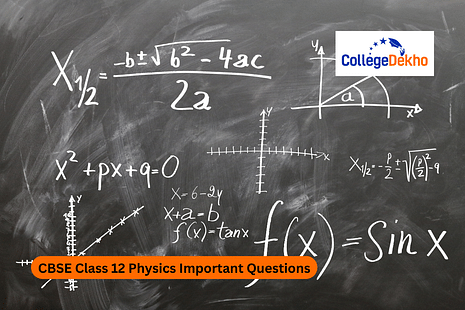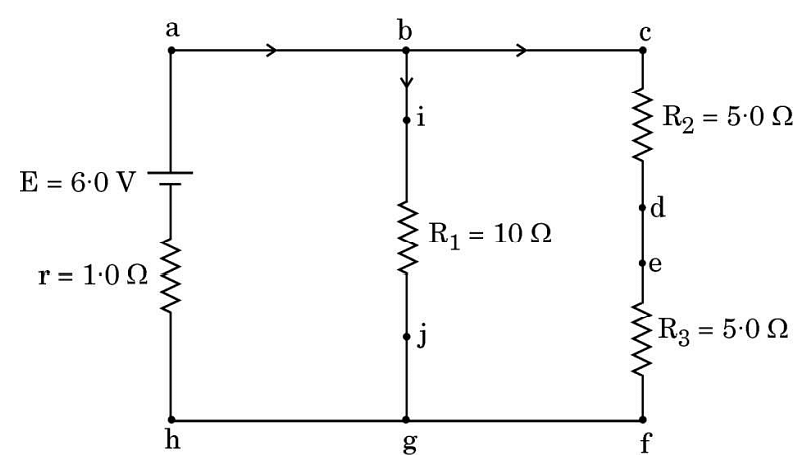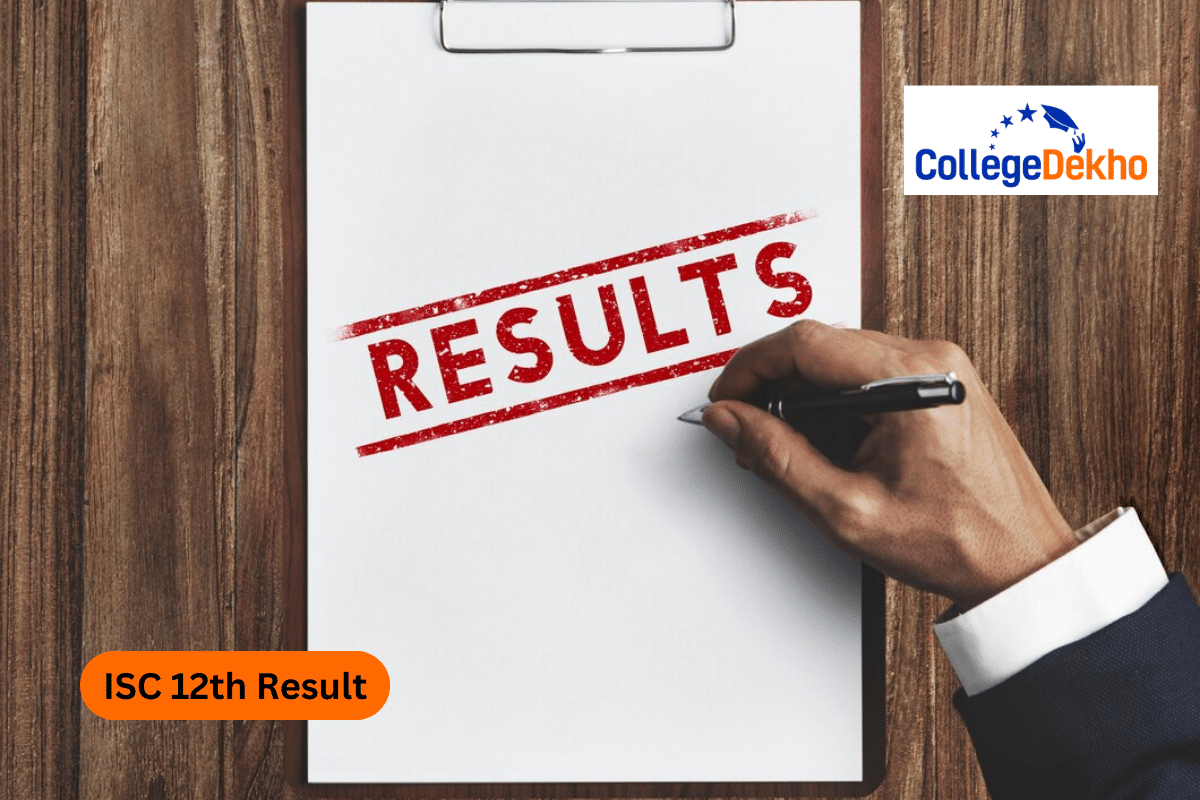- CBSE Class 12 Physics Important Questions 2024-25 For 5 Marks
- CBSE Class 12 Physics Important Questions 2024-25 For 3 Marks
- CBSE Class 12 Physics Important Questions 2024-25 For 1 Mark
- CBSE Class 12 Physics Chapter Wise Important Questions 2024-25
- CBSE Class 12 Physics Important Case Studies 2024-25
- CBSE Class 12 Physics Exam Pattern 2024-25
- Faqs


Never Miss an Exam Update
CBSE Class 12 Physics Important Questions 2024-25 must be solved by the students if they want to revise after completing their syllabus. The students need to practice for the board exams after they are done with their study session so that they can write the board exams swiftly. Make sure to solve as many questions as necessary to acquire the much-needed practice when sitting for the actual board exams. Students must also review the latest CBSE Class 12 Physics Syllabus 2024-25 and check the changes made by the Central Board of Secondary Education in the curriculum if any. To revise for the board exams, students can also use the CBSE Class 12 Physics Sample Paper 2024-25 .
Students must study for the board exams by following an effective study plan which gives more importance to the chapters with more weightage. It is essential to also go through the CBSE Class 12 Physics Previous Year Question Paper . The Physics question paper will consist of MCQs, very short answer type questions, short answer type questions, and long answer type questions to be answered by the students. The physics theory question paper will be conducted for 70 marks and the rest of the marks will be allotted for the practical session. Check out more information about the CBSE Class 12 Physics Important Questions 2024-25 here:
CBSE Class 12 Physics Important Questions 2024-25 For 5 Marks
The last section of the Physics question paper will consist of long answer-type questions for 5 marks each. Students can refer to some of the important 5 marks questions from the pointers given below and review them accordingly:
Question 1: (a) Describe briefly the process of transferring the charge between the two plates of a parallel plate capacitor when connected to a battery. Derive an expression for the energy stored in a capacitor.
(b) A parallel plate capacitor is charged by a battery to a potential difference V. It is disconnected from the battery and then connected to another uncharged capacitor of the same capacitance. Calculate the ratio of the energy stored in the combination to the initial energy on the single capacitor.
Question 2: The following figure shows a circuit diagram. We can find the currents through and potential differences across different resistors using Kirchhoff’s Rule.

Answer the following questions based on the above: (a) Which points are at the same potential in the circuit? (b) What is the current through arm bg? (c) Find the potential difference across resistance R3.
Question 3: (a) Three charges –q, Q, and –q are placed at equal distances on a straight line. If the potential energy of the system of these charges is zero, then what is the ratio Q:q?
(b)(i) Obtain the expression for the electric field intensity due to a uniformly charged spherical shell of radius R at a point distant r from the centre of the shell outside it. (ii) Draw a graph showing the variation of electric field intensity E with r, for r > R and r < R.
Question 4: Derive the expression for the torque acting on the rectangular current carrying coil of a galvanometer. Why is the magnetic field made radial?
(b) An -particle is accelerated through a potential difference of 10 kV and moves along x-axis. It enters in a region of uniform magnetic field B = 2 10–3 T acting along y-axis. Find the radius of its path. (Take mass of -particle = 6·4 10–27 kg )
Question 5: Draw the ray diagram of an astronomical telescope when the final image is formed at infinity. Write the expression for the resolving power of the telescope.
(b) An astronomical telescope has an objective lens of focal length 20 m and eyepiece of focal length 1 cm. (i) Find the angular magnification of the telescope. (ii) If this telescope is used to view the Moon, find the diameter of the image formed by the objective lens. Given the diameter of the Moon is 3·5 106 m and radius of lunar orbit is 3·8 108 m.
Also Check: CBSE Class 12 Exam Pattern 2024-25
CBSE Class 12 Physics Important Questions 2024-25 For 3 Marks
Section C will consist of 7 questions for 3 marks each. Students can review the important questions for three marks from the pointers given below:
Question 1: (a) If A and B represent the maximum and minimum amplitudes of an amplitude modulated wave, write the expression for the modulation index in terms of A & B.
(b) A message signal of frequency 20 kHz and peak voltage 10 V is used to modulate a carrier of frequency 2 MHz and peak voltage of 15 V. Calculate the modulation index. Why the modulation index is generally kept less than one?
Question 2: Draw the energy level diagram for hydrogen atom. Mark the transitions corresponding to the series lying in the ultraviolet region, visible region and infrared region.
Question 3: Two long straight parallel current carrying conductors are kept ‘a’ distant apart in air. The direction of current in both the conductors is same. Find the magnitude of force per unit length and direction of the force between them. Hence define one ampere.
Question 4: An a.c. source generating a voltage ε = ε0 sin ωt is connected to a capacitor of capacitance C. Find the expression for the current I flowing through it. Plot a graph of ε and I versus t to show that the current is ahead of the voltage by π/2.
Question 5: The binding energies per nucleon of the parent nucleus, the daughter nucleus and -particle are 7·8 MeV, 7·835 MeV and 7·07 MeV, respectively. Assuming the daughter nucleus to be formed in the unexcited state and neglecting its share in the energy of the reaction, find the speed of the emitted -particle. (Mass of -particle = 6·68 10–27 kg)
CBSE Class 12 Physics Important Questions 2024-25 For 1 Mark
The very first section of the question paper will consist of 16 questions including twelve MCQs and four Assertion Reasoning questions. Students can go through some important one-mark questions from the pointers given below:
Question 1: How does the mobility of electrons in a conductor change, if the potential difference applied across the conductor is doubled, keeping the length and temperature of the conductor constant?
Question 2: Why cannot we use Si and Ge in fabrication of visible LEDs?
Question 3: How does an increase in doping concentration affect the width of depletion layer of a p-n junction diode?
Question 4: Two statements are given-one labelled Assertion (A) and the other labelled Reason (R). Select the correct answer to these questions from the codes (a), (b), (c) and (d) as given below.
- a) Both A and R are true and R is the correct explanation of A
- b) Both A and R are true and R is NOT the correct explanation of A
- c) A is true but R is false
- d) A is false and R is also false
Assertion(A): The photoelectrons produced by a monochromatic light beam incident on a metal surface have a spread in their kinetic energies. Reason(R): The energy of electrons emitted from inside the metal surface, is lost in collision with the other atoms in the metal.
Question 5: . When alpha particles are sent through a thin gold foil, most of them go straight through the foil, because
(a) alpha particles are positively charged
(b) the mass of an alpha particle is more than the mass of an electron
(c) most of the part of an atom is empty space
(d) alpha particles move with high velocity
CBSE Class 12 Physics Chapter Wise Important Questions 2024-25
In this section, the high weightage carrying chapter-wise questions of CBSE Class 12 Physics are provided.
Chapter 8: Electromagnetic Waves
Question 1: A capacitor has been charged by a DC source. What are the magnitudes of conduction and displacement currents, when it is fully charged? (2 marks)
Question 2: When an ideal capacitor is charged by a DC battery, no current flows. However, when an AC source is used, the current flows continuously. How does one explain this, based on the concept of displacement current? (2 marks)
Question 3: (a) How are electromagnetic waves produced?
(b) How do you convince yourself that electromagnetic waves carry energy and momentum? (2 marks)
Chapter 9: Ray Optics and Optical Instruments
Question 1: State the conditions for the phenomenon of total internal reflection to occur. (2 marks)
Question 2: A converging lens is kept coaxially in contact with a diverging lens — both lenses being of equal focal lengths. What is the focal length of the combination? (2 marks)
Question 3: How would a biconvex lens appear when placed in a trough of liquid having the same refractive index as that of the lens? (2 marks)
Chapter 10: Wave Optics
Question 1: Laser light of wavelength 640 nm incident on a pair of slits produces an interference pattern in which the bright fringes are separated by 7.2 mm. Calculate the wavelength of another source of light which produces interference fringes separated by 8.1 mm using same arrangement. Also find the minimum value of the order ‘n’ of bright fringe of shorter wavelength which coincides with that of the longer wavelength. (3 marks)
Question 2: Yellow light (λ = 6000Å) illuminates a single slit of width 1 x 10-4 m. Calculate
(i) the distance between the two dark lines on either side of the central maximum, when the diffraction pattern is viewed on a screen kept 1.5 m away from the slit;
(ii) the angular spread of the first diffraction minimum. (2 marks)
Question 3: A parallel beam of light of 600 nm falls on a narrow slit and the resulting diffraction pattern is observed on a screen 1.2 m away. It is observed that the first minimum is at a distance of 3 mm from the centre of the screen. Calculate the width of the slit. (2 marks)
CBSE Class 12 Physics Important Case Studies 2024-25
According to the changes made by the Central Board of Secondary Education in the curriculum, a total of 2 case studies will also be included in the theory paper. Check out some important case studies here:
Case Study 1 - When p side of p-n junction is connected to positive terminal of battery and n side of p-n junction is connected to negative terminal of battery then the p-n junction is said to be in forward bias mode or forward biased. And When p side of p-n junction is connected to negative terminal of battery and n side of p-n junction is connected to positive terminal of battery then the p-n junction is said to be in reverse bias mode or reverse biased. The diode used to rectify an AC voltage is called as rectifier. Zener diode is also a p-n junction diode which works in reverse bias condition and used as voltage regulator. Also, p-n junction diodes are used in solar cells which is used to convert light energy into electrical energy. Light emitting diodes are also p-n junction diodes which are used to produce light. The digital circuit which gives the logical relationship between input and output voltage are called as logic gates. There are five basic gates namely NOT, AND, OR, NAND, NOR.
NOT gate is that logic gate which gives inverted input as output such as if 1 is the input given then output will be 0. The other logic gates OR, AND, NAND, NOR has two inputs and only one output.
Question 1 - Zener diode and photodiode work in the -
- a) forward bias mode
- b) reverse bias mode
- c) both a and b
- d) none
Question 2 - The semiconductors which are used to make visible LEDs must have a band gap of -
- a) 3 eV
- b) 0 eV
- c) 1.8 eV
- d) 5 eV
Question 3 - The rectifier in which the rectified output is only for half of the input AC wave is called as -
- a) full wave rectifier
- b) half wave rectifier
- c) transformer
- d) transducer
Case Study 2 - We know that, light waves are electromagnetic waves which are transverse in nature and having constant speed equal to 3*108m/s. The electric field vector and magnetic field vector are mutually perpendicular to each other and also perpendicular to the direction of propagation in Electromagnetic Waves. The light coming from the sun is the unpolarised light because electric filed vectors are oriented in all directions. When a unpolarised light is passed through the Polaroids, the Polaroids passes the light vectors which are vibrating along the axis of the Polaroid and the light coming out from it is called as the plane polarised light. But when such a plane polarised light is passed through the Polaroid whose axis is not along the light vectors of plane polarised light then there will be no light came out through the Polaroid. Polarisation of light can occur by reflection and scattering of light also. In case of polarisation by reflection, when an unpolarised light is incident on the interface separating two transparent media then the reflected light is polarised light whose light vectors are perpendicular to the plane of incidence only when reflected and refracted rays makes an angle of 90°. And in such case, for which angle between reflected and refracted ray is 90°, the reflected light is totally get polarised. And the angle of incidence for which the reflected wave get totally polarised is called as Brewster’s angle and denoted as iB.
Question 1 - Polarisation of light also takes place by reflection only when the angle of incidence is ____
- a) 90°
- b) critical angle
- c) Brewster’s angle
- d) less than 90°
Question 2 - The polarization of light can take place when light is scattered through ____ in the atmosphere.
- a) π
- b) less than π
- c) π/2
- d) 2π
Question 3 - Polarisation of light explains the _____ nature of light.
- a) particle
- b) photon
- c) wave
- d) both wave and particle
CBSE Class 12 Physics Exam Pattern 2024-25
Students can refer to the detailed information about the CBSE Class 12 Physics Exam Pattern 2024-25 from the table given below:
Unit | Chapters | No. of Periods | Marks |
|---|---|---|---|
Unit 1 | Electrostatics | 26 | 16 |
Chapter 1: Electric Charges and Fields | |||
Chapter 2: Electrostatic Potential and Capacitance | |||
Unit 2 | Current Electricity | 18 | |
Chapter 3: Current Electricity | |||
Unit 3 | Magnetic Effects of Current and Magnetism | 25 | 17 |
Chapter 4: Moving Charges and Magnetism | |||
Chapter 5: Magnetism and Matter | |||
Unit 4 | Electromagnetic Induction and Alternating Currents | 24 | |
Chapter 6: Electromagnetic Induction | |||
Chapter 7: Alternating Current | |||
Unit 5 | Electromagnetic Waves | 04 | 18 |
Chapter 8: Electromagnetic Waves | |||
Unit 6 | Optics | 30 | |
Chapter 9: Ray Optics and Optical Instruments | |||
Chapter 10: Wave Optics | |||
Unit 7 | Dual Nature of Radiation and Matter | 08 | 12 |
Chapter 11: Dual Nature of Radiation and Matter | |||
Unit 8 | Atoms and Nuclei | 15 | |
Chapter–12: Atoms | |||
Chapter–13: Nuclei | |||
Unit 9 | Electronic Devices | 10 | 7 |
Chapter 14: Semiconductor Electronics: Materials, Devices and Simple Circuits | |||
Total | 160 | 70 |
Students must solve as many CBSE Class 12 Physics Important Questions 2024-25 as they can. Immense practice will be required by the students so that they can get good marks in the class 12th board exams.























